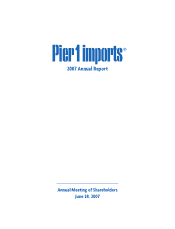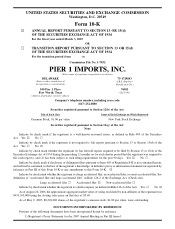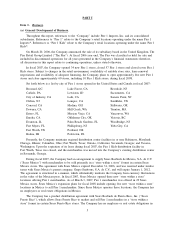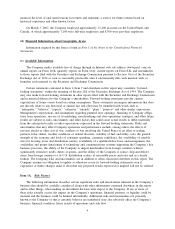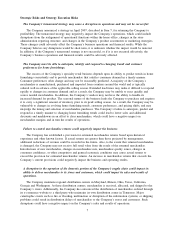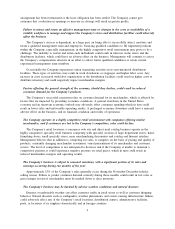Pier 1 2007 Annual Report Download - page 10
Download and view the complete annual report
Please find page 10 of the 2007 Pier 1 annual report below. You can navigate through the pages in the report by either clicking on the pages listed below, or by using the keyword search tool below to find specific information within the annual report.The success of the business is dependent on factors affecting consumer spending that are not controllable
by the Company.
Consumer spending, including spending for the home and home-related furnishings, are dependent upon
factors that include but are not limited to general economic conditions, levels of employment, disposable
consumer income, prevailing interest rates, consumer debt, costs of fuel, recession and fears of recession, war
and fears of war, inclement weather, tax rates and rate increases, consumer confidence in future economic
conditions and political conditions, and consumer perceptions of personal well-being and security. Unfavorable
changes in factors affecting discretionary spending could reduce demand for the Company’s products and
therefore lower sales and negatively impact the business and its operating results.
Factors that may or may not be controllable by the Company may adversely affect the Company’s finan-
cial performance.
Increases in the Company’s expenses that are beyond the Company’s control including items such as
higher interest rates, increases in fuel and transportation costs, increases in losses from damaged merchandise,
inflation, higher costs of labor, insurance and healthcare, increases in postage and media costs, higher tax rates
and changes in laws and regulations, including accounting standards, may increase the Company’s cost of sales
and selling, general and administrative expenses, negatively impacting the Company’s operating results.
Failure to successfully manage and execute the Company’s marketing initiatives could have a negative
impact on the business.
The success and growth of the Company is partially dependent on generating customer traffic in order to
gain sales momentum in its stores and on its e-commerce web site. Successful marketing efforts require the
ability to reach customers through their desired mode of communication utilizing various media outlets. Media
placement decisions are generally made months in advance of the scheduled release date. The Company’s
inability to accurately predict its consumers’ preferences may negatively impact the business and operating
results.
Changes to estimates related to the Company’s property and equipment, or operating results that are
lower than its current estimates at certain store locations, may cause the Company to incur impairment
charges on certain long-lived assets.
The Company makes certain estimates and projections with regards to individual store operations in
connection with its impairment analyses for long-lived assets in accordance with SFAS No. 144, “Accounting
for the Impairment or Disposal of Long-Lived Assets.” An impairment charge is required when the carrying
value of the asset exceeds the estimated fair value or undiscounted future cash flows of the asset. The
projection of future cash flows used in this analysis requires the use of judgment and a number of estimates
and projections of future operating results. If actual results differ from the Company’s estimates, additional
charges for asset impairments may be required in the future. If impairment charges are significant, the
Company’s results of operations could be adversely affected.
Risks Related to Store Profitability
The Company’s success depends, in part, on its ability to operate in desirable locations at reasonable
rental rates and to close underperforming stores at or before the conclusion of their lease terms.
The profitability of the business is dependent on opening and operating new stores at a reasonable profit,
maintaining and growing the current store base at a reasonable profit, and identifying and closing under-
performing stores. For a majority of the Company’s current store base, a large portion of a stores’ operating
expense is the cost associated with leasing the location. Management actively monitors individual store
performance to ensure stores can remain profitable or have the ability to rebound to a profitable state. Current
locations may not continue to be desirable as demographics change, and the Company may choose to close an
underperforming store before its lease expires. If management chooses to close an existing store before its
lease expiration, the Company could suffer operating losses until the lease term expires or until the lease
8

